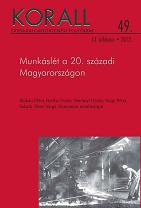Mit ér a munkás, ha paraszt (is)? A falusi munkásság és a hatalom a Kádár-korszakban
What is a Worker Worth, if he’s a Peasant (too)? Rural Workers and Power in the Kádár-era
Author(s): Zsuzsanna VargaSubject(s): History
Published by: KORALL Társadalomtörténeti Egyesület
Summary/Abstract: It is a widely known fact that the influx of various groups of rural population into industry was accelerated significantly by the repeated collectivisation campaigns. In many cases, however, those leaving agriculture behind changed their occupation, but not their place of residence. This was one of the survival strategies employed by peasant families. By ‘standing on more than one leg’, a large number of rural families adopted a mixed occupation structure. The contribution of the family member working in industry made the family income higher and more evenly distributed, and their social security and pensions were more favourable than those employed in agriculture too. In return, the Establishment expected them to adapt a ‘conscious worker’ identity. At the same time, on the turn of 1960s and 1970s, it became clear that large numbers of industrial workers who were formerly employed in agriculture were far from the norm that the Establishment prescribed for industrial workers. The study examines how the party-state handled the paradoxical situation, in which over half of all Hungary’s industrial workers lived in rural settlements. In addition, it aims to describe the interpretive frameworks that built up around the double lives of this unique social group. Documents of the increasingly bitter debate over income policies in the late 1960s provide an excellent resource for this analysis.
Journal: Korall - Társadalomtörténeti folyóirat
- Issue Year: 2012
- Issue No: 49
- Page Range: 37-57
- Page Count: 21
- Language: Hungarian

